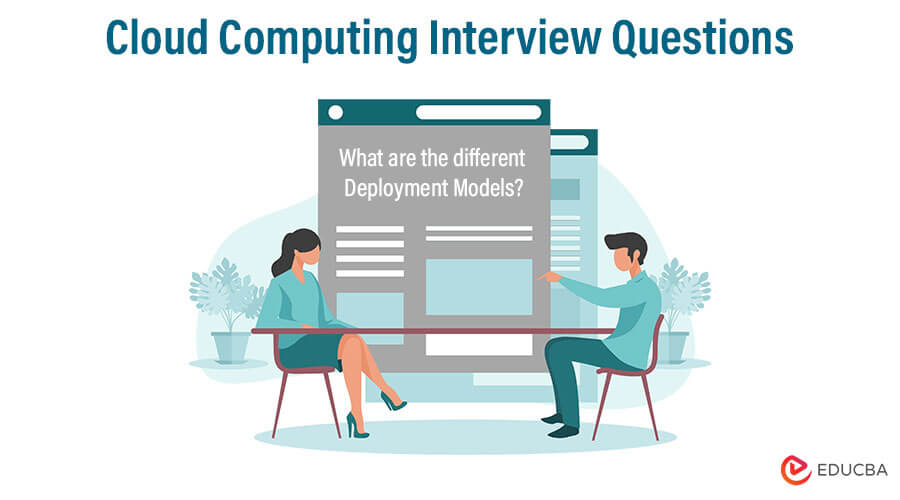Updated June 23, 2023
Introduction to Cloud Computing Interview Questions
You have finally found your dream job in Cloud Computing but are wondering how to crack the 2023 Cloud Computing Interview and what could be the probable Cloud Computing Interview Questions. Every interview is different, and the job scope is different too. Keeping this in mind, we have designed the most common Cloud Computing Interview Questions and answers to help you get success in your interview. Below are some of the top Cloud Computing Interview Questions to help in the technical interview.
Cloud Computing Interview Questions
Following is the list of Cloud Computing Interview Questions that are primarily asked in an interview
1. What is Cloud and Cloud Computing?
Answer:
Cloud: A cloud is a term comprised of hardware, storage, services, and interfaces that help in providing computing as a service from a remote location. It has three kinds of users:
- End Users
- Cloud Service Provider
- Business ManagementUsers
Cloud Computing: Cloud computing refers to the provision of computing power, database storage, applications, and various IT resources on-demand through a cloud services platform. This delivery is facilitated over the internet, enabling the cloud to provide services globally.
A user can manipulate, configure, and access the hardware and software resources remotely in cloud computing.
2. What are the different service models for Cloud Computing?
Answer:
There are different kinds of cloud service models. Below are three primary models, a diverse business using some or all of these models as per the requirement:
- Software as a Service (Saas): SaaS model provides a software application and programs service to the end-user; all applications and programs are managed cloud-based.
- Platform as a Service (PaaS): PaaS model provides an environment, platform, and operating system layer via the internet to a developer to develop applications and services.
- Infrastructure as a Service (IaaS): IaaS isan essential cloud computing service; it provides the infrastructure to access computing resources in a virtualized online environment.
3. What are the different Deployment Models?
Answer:
Cloud computing supports several deployment models with services and operations in a cloud environment. A larger organization uses the private cloud, whereas small businesses utilize the public cloud; below are some of the deployment models:
- Private Cloud: It may reside on or off-premises. Organizations opt for private cloud for sensitive and critical information as it provides security, reliability, and service and can scale.
- Community Cloud: A specific community or group is granted access to this infrastructure, enabling multiple organizations like banks and trading firms to share its resources. It can be located on-premises or in a remote data center and can be hosted internally or externally.
- Public Cloud: Public cloud infrastructure is open for use by the public. It is more secure than accessing information via the Internet.
The public cloud provides collaboration, CRM, Storage, and social networking functions.
- Hybrid Cloud: It combines multiple cloud deployment models as distinct entities, which are interconnected using standardized or proprietary technology. This allows for the portability of data and applications across different clouds.
4. What are some security measures provided by a cloud?
Answer:
There are many levels of security within a cloud environment, such as:
- Identity Management: Identity management controls access to information, computing resources, applications, and services, ensuring that only authorized users are able to utilize them.
- Access Control: As data can be accessed from anywhere in the cloud, it is important to provide permissions to users to control access for other users to enter the cloud.
5. How can a company benefit from cloud computing?
Answer:
There are many advantages of cloud computing for any organization. Below are some of the benefits of cloud computing
- Lower IT infrastructure and computer costs for users
- More secure data backup
- Data storage (Relational, No-SQL, Block Storage)
- Increased productivity
- Sandboxing and virtualization capabilities
- Increased productivity
- Cost Effectiveness
- Better for growth and scalability
- Take advantage of powerful server capabilities without hardware investment.
- Software as a Service. (SaaS)
6. Name the platforms which are used for large-scale cloud computing.
Answer:
Cloud provides many platforms for cloud computing, but as the emergence of the big data cloud needed large-scale distributed computing, the platform is as follows:
- Apache Hadoop: Apache Hadoop is an open-source technology. Hadoop provides services like data storage, processing, access, governance, security, and operations.
- MapReduce: MapReduce is a framework for processing large-scale data generated in structured, unstructured, or semi-structured formats. MapReduce uses cloud sources and commodity hardware to process data. By replicating the same data three (default replication factor = 3) times, it provides fault tolerance and scalability at a software level.
7. Why API’s are used in cloud services?
Answer:
- The user doesn’t need to write a complete program as it provides an inbuilt programming interface.
- The suggestion and instructions will pop up to make a connection between one or more applications.
8. Name some of the Cloud Computing platform databases.
Answer:
- MongoDB
- CouchDB
- LucidDB
- DynamoDB-Amazon
9. Name some essential characteristics of Cloud Computing.
Answer:
Below are some of the essential characteristics of cloud computing:
- On-demand self-service with a provision of storage, computing, etc.
- Support rapid elasticity so that it can grow and shrink as per the requirement.
- Measured Services with a pay-as-you-go pricing model.
10. Name the Data Centers in Cloud Computing.
Answer:
- Containerized data center
- Low-density data center
Recommended Articles
We hope that this EDUCBA information on “Cloud Computing Interview Questions” was beneficial to you. You can view EDUCBA’s recommended articles for more information.


